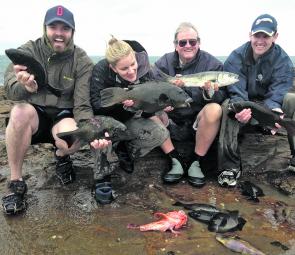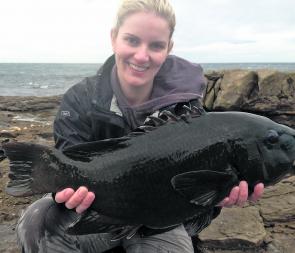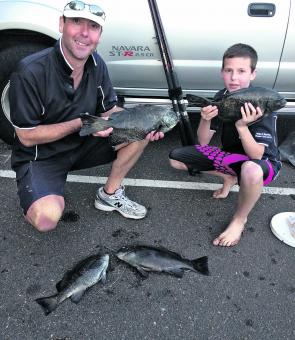Cool mornings and balmy, warm days, but the ocean water is still around its minimum for the year.
Species like rock blackfish, groper and luderick are the most common fish sought after this month.
Another fish worth pursuing is the hard fighting silver drummer. I have been catching some lately up to 5kg, not whoppers by silver drummer standards but great sport on 5kg-7kg outfits.
Cunjevoi is normally the best bait for these but peeled prawns work OK, too.
Once hooked, the standard ‘pig’ or rock blackfish will attempt to swim into a cave or under a ledge, whereas silvers will not.
Silvers are known for their kelp-chomping teeth and sharp gill plates, which often damage or sever the line. A long-shank hook like the Mustad Big Red or 92247 will give the silver some metal to chew on, rather than line.
Another bait worth using is kelp – yes, kelp! – under a float on a hook baited up with this rubbery brown weed baited up like a fish fillet. It works OK but only on silvers.
Silvers are renowned for their poor eating qualities but that’s not necessarily true. Fillet, skin and bone the fish; a sizeable fish has a fillet at least 3cm-4cm.
I like to cut it at a 45° angle and about 5mm thick. Coat the small fish pieces in cornflour. Fry up in olive or canola oil for about one minute and pop onto a paper towel. Stir-fry your chopped vegies in a wok and when 80% done, add your fish for the last minute and pour some hot chilli and oyster sauce. Serve with steamed rice.
This month you will notice an increase in cabbage weed in the intestines of the rock blackfish. That’s a good reason to use cabbage bait under a float or ‘pussy footing’ for them; often the fish are of better quality.
Try a small foam float and fish 1m-2m deep, sometimes deeper, depending on the bottom and how undulating it is. Use a barrel or ball sinker sliding down to the swivel and a 30cm leader and a No 2-1/0 double-strength hook.
Main line should be 6kg-12kg braid or mono, with a leader of 8kg-12kg fluorocarbon.
Fish the boulder and ledge wash zones and have white bread and prawns on stand-by as back-up baits because the cabbage may not work on the day.
This month expect the occasional big silver trevally from 1.5kg-3kg. These fish are awesome fun on 4kg-6kg line, stripping off several metres as they make their first run.
Big tarwhine will also be more of a presence for the next couple of months. Prawns are best for the tarwhine and prawns and pilchards for the trevallly.
Fish right on the crack of dawn, or even earlier if it’s safe to do so. Try the south side of Long Reef at low tide for the big ‘blurters’.
For the pigs, North Avalon, South Avalon, Warriewood, Long Reef and The Hat at the Harbour entrance are the places to fish. At some of these locations you may need to take in your on cabbage weed and cabbage berley.
For the silver drummer try Bangalley Head and Long Reef.
For a luderick session, try the Bangalley Head ledges, gutters at Warriewood and Narrabeen (providing that one is not sanded up), the flats on the north side of Long Reef, Flat Rock at South Curl Curl and Manly’s Little Bluey.
Catching big pigs on light line can be very exhilarating and consistently productive this month. On Craig McGill’s Local Knowledge DVD I was luderick fishing in the conventional style and landed a 3kg pig on 2.7kg line. Pages and pages can be written on of fighting strategies and how to coax reef species from their rocky homes. To put it simply, play any fish without jerky short strokes and play it out more lightly.
The beaches can be a little quiet at this time of year but that doesn’t mean that it is not worth having a go.
Bream numbers are going to increase providing the seas are not flattened by the westerly winds that can spill over from September.
Tarwhine numbers should increase as well.
I am one of those anglers who look forward to all species of fish to come on or migrate because I appreciate what they can offer as sport fish, table fare and just general appreciation of virtually all species.
Tarwhine are always welcome. They might look much like bream but they are quite different, with more rounded heads light lengthwise striping and, when you go to clean your catch, a black lining to their gut cavity.
Off the beaches there is a run of these fish for 8-10 weeks and if you run into quality fish from 900g-1.3kg, you will have the time of your life. On 2kg-3kg line they will strip metres of line from your egg-beater or make your Alvey spin hard.
Tarwhine are not highly regarded as a table fish. It is common knowledge that a 1.5kg or smaller mulloway is a mushy fish, hence the nickname ‘soapy jew’.
The same applies with a small tarwhine. Even though the legal length is just 20cm, they are mushy fleshed until they are about 25cm-27cm. The best table quality is from around 750g and up.
The best baits for tarwhine are normally crustaceans like prawns, sand crabs and pink nippers. Fish a paternoster rig with a single No 1 or 1/0 hook with the correct size sinker according to the drift. Try gutters on beaches like Freshwater, Dee Why or Warriewood.
If you’re keen for a whiting, try Curl Curl or Dee Why, beach have resident fish to 33cm. Try pink nippers, live beach worms or if you can purchase them, bloodworms.
You can harvest bloodworms in Sydney. Check out the DPI website for legal harvesting areas. Squirt worms or bloodworms are best for whiting.
Reads: 2306
Magic family moments: From left, Mitch, Sharleen, Peter and Keanen Wood ith the fruits of their labour from the rocks.

Catch of the day: Sharleen Wood tussled with this 4kg brown groper on 7kg braid while fishing for pigs.

Geoff and son George, 13, did well for their first time on the rocks with four pigs to 1.8kg.

Mitch Wood caught this pig that had escaped a spearfisher. The lucky fish was photographed and released. How tough are these fish!




